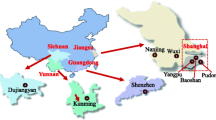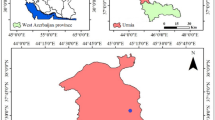Abstract
This study was carried out to determine the concentration of heavy metals (Cd, Ni, Pb, Cr, Ni and Zn) in ordinary Portland cement (OPC) produced from the co-processing with hazardous waste in comparison with OPC produced using natural raw materials. The results showed that the concentration of heavy metals in cement produced from natural raw material was in the order of Zn > Pb > Cr > Ni > Cu > Cd. Zn and Cd were the highest and the lowest concentrations, respectively, in cements produced from the co-processing activity. The difference between heavy metals concentrations in OPC produced with and without co-processing was found to be statistically significant. The concentration of heavy metals in the cement produced is generally factory dependent. The human risk assessment associated with the heavy metals for non-carcinogenic and carcinogenic risks has been evaluated. The calculated hazard index (HI) and total lifetime cancer risks (LCR) were lower than the acceptable threshold reference values, HI < 1 and LCR < 1 × 10−4, respectively. Thus, it is anticipated that there is no potential of non-carcinogenic and carcinogenic risks for both adult and children. However, the findings indicated that there is a need for regulatory monitoring. The exposure pathway for both non-carcinogenic and carcinogenic risks are both in the order of ingestion > dermal > inhalation.



Similar content being viewed by others
References
Achternbosch M, Bräutigam KR, Hartlieb N, Kupsch C, Richers U, Stemmermann P (2005) Impact of the use of waste on trace element concentrations in cement and concrete. Waste Manage Res 23:328–337
Alexander G (2000) Health risk appraisal. Int Electron J Health Educ 3:133–137
Chang SW, Shon WJ, Lee WC, Kum KY, Baek SH, Bae KS (2010) Analysis of heavy metal contents in gray and white MTA and 2 kinds of Portland cement: a preliminary study. Oral Surg, Oral Med, Oral Pathol, Oral Radiol, and Endodontol 109:642–646
Cipurkovic A, Trumic I, Hodžic Z, Selimbašic V, Djozic A (2014) Distribution of heavy metals in Portland cement production process. Adv Appl Sci Res 5(6):252–259
Cocarta DM, Rada EC, Ragazzi M, Badea A, Apostol T (2009) A contribution for a correct vision of health impact from municipal solid waste treatments. Environ Technol 30(9):963–968
Cocarta DM, Neamtu S, Resetar-Deac AM (2016) Carcinogenic risk evaluation for human health risk assessment from soils contaminated with heavy metals. Int J Environ Sci Technol 13:2025. doi:10.1007/s13762-016-1031-2
Department of Environment Malaysia (DOE) (2015) Environmental Quality Report 2014
Diami SM, Kusin FM, Madzin Z (2016) A review of the importance of hydraulic residence time on improved design of mine water treatment systems. Environ Sci Pollut Res 23(20):21086–21097
Hart BA (2000) Responses of the respiratory tract to cadmium. In: Zalups RK, Koropatnick J (eds) Molecular biology and toxicology of metals. Taylor and Francis Inc., London and New York, pp 208–233
Holcim Group GTZ (2006) Guidelines on co-processing waste materials in cement production. The GTZ-Holcim Public Private Partnership. Holcim Group Support Ltd and Deutsche Gesellschaft für Technische Zusammenarbeit (GTZ) GmbH
Ibrahim HH, Birnin-Yauri UA, Muhammad C, Umar A (2012) Assessment of pollution potentialities of some Portland cement. Niger J Basic and Appl Sci 20(2):182–184
International Agency for Research on Cancer (IARC) (2012) International Agency for Research on Cancer, Lyon
Karim Z, Qureshi BA (2013) Health risk assessment of heavy metals in urban soil of Karachi. Pakistan Hum Ecol Risk Assess 20:658–667
Khan S, Cao Q, Zheng YM, Huang YZ, Zhu YG (2008) Health risks of heavy metals in contaminated soils and food crops irrigated with wastewater in Beijing. China Environ Pollut 152:686–692
Kumar B, Verma VK, Kumar S, Sharma CS (2013) Probabilistic health risk assessment of polycyclic aromatic hydrocarbons and polychlorinated biphenyls in urban soils from a tropical city of India. J Environ Sci Health 48:1253–1263
Kusin FM, Zahar MSM, Muhammad SN, Mohamad ND, Madzin Z, Sharif SM (2016) Hybrid off-river augmentation system as an alternative raw water resource: the hydrogeochemistry of abandoned mining pond. Environ Earth Sci 75(3):230
Kusin FM, Rahman MSA, Madzin Z, Jusop S, Mohamat-Yusuff F, Ariffin M, Zahar MSM (2017) The occurrence and potential ecological risk assessment of bauxite mine-impacted water and sediments in Kuantan, Pahang. Malaysia Environ Sci & Pollut Res 24(2):1306–1321
Lee SW, Lee BT, Kim JY, Kim KW, Lee JS (2006) Human risk assessment for heavy metals and as contamination in the abandoned metal mine areas. Korea Environ Monit Assess 119(1–3):233–244
Li Z, Ma Z, Kuijp TJ, Yuan Z, Huang L (2014) A review of soil heavy metal pollution from mines in China: pollution and health risk assessment. Sci Total Environ 15(486–469):843–853
Lu Y, Gong Z, Zhang G, Wolfgang B (2003) Concentrations and chemical speciations of Cu, Zn, Pb, and Cr of urban soils in Nanjing, China. Geoderma 115:101–111
Lu H, Wei F, Tang J, Giesy JP (2016) Leaching of metals from cement under simulated environmental conditions. J Environ Manage 169:319–327
Luo XS, Ding J, Xu B, Wang YJ, Li HB, Yu S (2012) Incorporating bioavailability into human health risk assessments of heavy metals in urban park soils. Sci Total Environ 424:88–96
Ogunbileje JO, Sadagoparamanujam VM, Anetor JI, Farombi EO (2013) Lead, mercury, cadmium, chromium, nickel, copper, zinc, calcium, iron, manganese and chromium (VI) levels in Nigeria and United States of America cement dust. Chemosphere 9:2743–2749
Ogunkunle CO, Fatoba PO, Ogunkunle MO, Oyedeji AA (2013) Potential health risk assessment for soil heavy metal contamination of Sagamu, South-west Nigeria due to cement production. Int J Appl Sci Technol 3(2):89–96
Parizanganeh AH, Bijnavand V, Zamani AA, Hajabolfath A (2012) Concentration, distribution and comparison of total and bioavailable heavy metals in top soils of Bonab District in Zanjan Province. Open J Soil Sci 2:123–132
Praveena SM, Yuswir NS, Aris AZ, Hashim Z (2015a) Contamination assessment and potential human health risks of heavy metals in Klang urban soils: a preliminary study. Environ Earth Sci 73:8155–8165
Praveena SM, Mutalib NSA, Aris AZ (2015b) Determination of heavy metals in indoor dust from primary school (Sri Serdang, Malaysia): estimation of the health risks. Environ Forensics 16:257–263
Scragg A. (2006). Environmental biotechnology. Oxford, 2nd (ed), Oxford University Press, UK, pp 67
Stafforda FN, Viquez MD, Labrincha J, Hotz D (2015) Advances and challenges for the co-processing in Latin American cement industry. Proced Mater Sci 9:571–577
Trezza MA, Scian AN (2007) Waste in chrome in Portland cement clinker production. J Hazard Mater 147:188–196
US Department of Energy (2011) The risk assessment information system (RAIS). US Department of Energy’s Oak Ridge Operation Office, Washington
US Environmental Protection Agency (USEPA) (2002) Supplemental guidance for developing soil screening levels for superfund sites. Office of Emergency and Remedial Response, Washington
US Environmental Protection Agency (USEPA) (2011) Exposure factors handbook 2011. National Center for Environmental Assessment, Washington
Usón AA, López-Sabirón AM, Ferreira G, Sastresa EL (2013) Uses of alternative fuels and raw materials in the cement industry as sustainable waste management options. Renew Sustain Energy Rev 23:242–260
Wuana RW, Okieimen FE (2011) Heavy metals in contaminated soils: a review of sources, chemistry, risks and best available strategies for remediation. ISRN Ecol, Article ID 402647, pp 20, doi.org/10.5402/2011/402647
Yan DH, Karstensen KH, Huang Q, Wang FQ, Cai ML (2010) Co-processing of industrial and hazardous wastes in cement kilns: a review of current status and future need in China. Env. Eng. Sci. 27:37–45
Yuswir NS, Praveena SM, Aris AZ, Ismail SNS, Hashim Z (2015) Health risk assessment of heavy metal in urban surface soil (Klang District, Malaysia). Bull Environ Contam Toxicol 95:80–89
Zhang J, Liu J, Li C, Jin Y, Nie Y, Li J (2009) Comparison of the fixation effects of heavy metal by cement rotary kiln co-processing and cement based solidification/stabilization. J Hazard Mater 165:1175–1185
Zhao L, Xu Y, Hou H, Shangguan Y, Li F (2014) Source identification and health risk assessment of metals in urban soils around the Tanggu chemical industrial district, Tianjin, China. Sci Total Environ 468:654–662
Acknowledgements
The authors would like to acknowledge the Putra IPM research Grant No. 9433300 for providing the financial support for this study. Special thanks are due to laboratory staffs of Faculty of Environmental Studies and Ms Aiza and Ms Aimie for their assistance during the field sampling and experimental works.
Author information
Authors and Affiliations
Corresponding author
Additional information
Editorial responsibility: Agnieszka Galuszka.
Rights and permissions
About this article
Cite this article
Halim, N.A., Kusin, F.M. & Mohamed, K.N. Heavy metal exposure from co-processing of hazardous wastes for cement production and associated human risk assessment. Int. J. Environ. Sci. Technol. 15, 733–742 (2018). https://doi.org/10.1007/s13762-017-1431-y
Received:
Revised:
Accepted:
Published:
Issue Date:
DOI: https://doi.org/10.1007/s13762-017-1431-y




